THE SAFETY NET
Many falls happen at home, where we spend much of our time and tend to move around without thinking about our safety. There are many changes you can make to your home that will help prevent falls and better ensure your safety.

LOCATION CONSULTING DESIGN & ENGINEERING DESIGN-BUILD CONSTRUCTION & CONTRACTING APRIL 2023 VOLUME 17 ISSUE 4 SAFE T Y FIRST. Austin employees have worked 5,521,666 hours without a Lost Time Accident through 03/2023.
IT’S ALWAYS SAFETY FIRST. CONSULT • DESIGN • ENGINEER • CONSTRUCT Preventing Falls at Home: Room
Room 04.17.2023 | National Institues of Health (NIH)
by
FLOORS, STAIRWAYS, AND HALLWAYS
• Ensure there are handrails on both sides of any stairs, and make sure they are secure. Hold the handrails when you go up or down stairs, even when you are carrying something. Don’t let anything you’re carrying block your view of the steps.
• Ensure there is good lighting with light switches at the top and bottom of stairs and on each end of a long hall. Consider using motion-activated lights that plug into electrical outlets and automatically turn on when you walk by them to help illuminate stairwells and pathways.
• Keep areas where you walk tidy. Don’t leave books, papers, clothes, or shoes on the floor or stairs.
• Check that all carpets are fixed firmly to the floor, so they won’t slip. Put no-slip strips, which you can buy at any hardware store, on tile and wooden floors.
• Don’t use throw rugs or small area rugs.

• Don’t walk on slippery, newly washed floors.
BATHROOMS
• Mount grab bars near toilets and on both the inside and outside of your tub and shower.

• Place nonskid mats, strips, or carpet on all surfaces that may get wet.
• Remember to leave a light on in the bathroom at night or use a night light that turns on automatically in the dark.
BEDROOMS
• Put night lights and light switches close to your bed.
• Keep a flashlight by your bed in case the power goes out and you need to get up.
• Place a landline or well-charged phone near your bed.
KITCHEN
• Keep frequently used pots, pans, and kitchen utensils in a place where they are easy to reach.
• Clean up spills immediately.
• Prepare food while seated to prevent fatigue or loss of balance.
OUTDOOR SPACES
• If you have steps leading to your front door, make sure they are not broken or uneven.
• Add non‐slip material to outdoor stairways.
• Keep the lawn, deck, or porch areas clear of debris, such as fallen branches.
• Consider installing a grab bar near the front door to provide balance while you are locking or unlocking the door.
• Turn on your porch light at night and if you leave during the day but plan on returning home after dark.
• In the winter, treat outdoor walkways with an ice melt product or sand to make them less slippery.
OTHER LIVING AREAS
• Keep electrical cords near walls and away from walking paths.
• Arrange your furniture (especially low coffee tables) and other objects so they are not in your way when you walk.
• Make sure your sofas and chairs are the right height for you to get in and out of easily.
• Keep items you use often at waist level or within easy reach.
• Don’t stand on a chair or table to reach something that’s too high — use a “reach stick” instead or ask for help. Reach sticks are special grabbing tools that you can buy at many hardware or medical-supply stores. If you use a step stool, make sure it’s steady and has a handrail on top. Have someone stand next to you.

• Don’t let your cat or dog trip you. Know where your pet is whenever you’re standing or walking.
• Keep a list of emergency numbers in large print near each landline phone and save them under “favorites” on your mobile phone.
If you have fallen, your doctor might suggest that an occupational therapist, physical therapist, or nurse visit your home. These health care providers can assess your home’s safety and advise you about making changes to lower your risk of falls.
TOOLS TO GET HELP
If you’re concerned about falling, set up systems to ensure you can get help if you fall. One option is installing an emergency response system. If you fall or need emergency help, you push a button on a special necklace or bracelet to alert 911. There is a fee for this service, and it’s usually not covered by insurance.
Another option is to carry a well-charged cordless or mobile phone with you as you move throughout the house. Have close friends and family on speed dial. Consider setting up a smart home device (a small speaker that listens and responds to commands when you call its name) that can quickly connect you to contacts or emergency response teams. Some smartwatches can be set up to make emergency calls at the push of a button and others can even detect sudden fall-like movements and automatically call for help. Ask family and friends for help setting up these tools.
HOME IMPROVEMENT RESOURCES
Many state and local governments have education and/ or home modification programs to help older people prevent falls. Check with your local health department, search the Eldercare Locator, or call 800-677-1116 to find your local Area Agency on Aging to see if there is a program near you.
3
Fall Injury Incidents
04.01.2022 | Weeklysafety.com
TAccording to recent fatal injury statistics (BLS.gov), there are more than 600 fatal falls annually. Many workers may be surprised to hear that about 2 out of every 3 are falls from less than 20 feet high.
Workers should be very aware of their work at any height. Look at the incidents described in this topic to help find out how to avoid and prevent serious and deadly situations on their job sites.
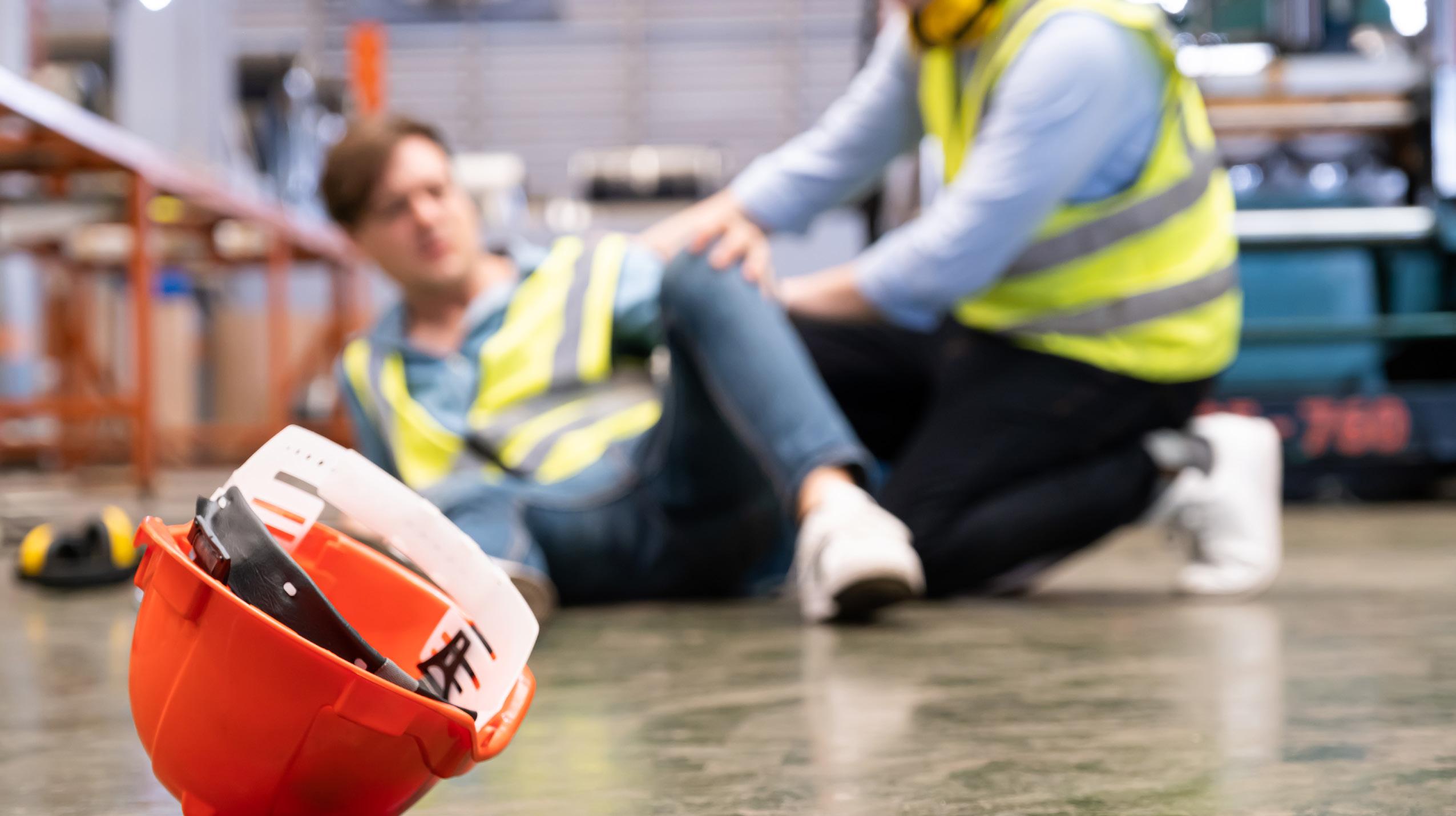
OSHA Standard 1926.501(b)(1) “Unprotected sides and edges.” Each employee on a walking/working surface (horizontal and vertical surface) with an unprotected side or edge which is 6 feet (1.8 m) or more above a lower level shall be protected from falling…
A 33-year-old worker was injured after a fall from an 8-foot step ladder. The victim was cleaning windows when he fell onto a tiled floor and hit his head. Although the victim was taken to the hospital quickly, he died the following morning from his injuries.
According to the investigators it is believed that the victim was standing backwards on the step ladder, facing away from the step ladder and working from the top step of the ladder.
• Never stand on the top step of a step ladder.
• Always face the ladder when climbing up or down the ladder and working.
NIOSH In-house Fatality Report 2009-01
OSHA Standard 1926.1053(b)(13) The top or top step of a stepladder shall not be used as a step.
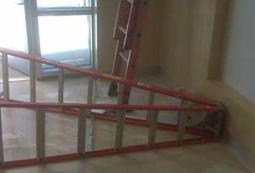 Image from the scene of a fatal incident when a 33-year old fell 8 feet from his step ladder. (*4)
Image from the scene of a fatal incident when a 33-year old fell 8 feet from his step ladder. (*4)
Image from the scene of a fatal incident when a supervisor fell through a skylight. (*6)
A supervisor died when he fell through a skylight while moving a vacuum hose. The victim was supervising the vacuuming of roof rock off a flat roof when he picked up the hose to move it out of the way of the vacuum operator. As the victim was moving the hose, he fell through the skylight.
The key factor that contributed to the victim’s death was working in close proximity to an unguarded skylight.
• Never work near unprotected skylights, sides, or edges.
• Supervisors and workers should perform a walk-around inspection of their site before starting work to find any possible fall hazards.
California Fatality Report #11CA004
The foreman was not wearing a personal fall arrest system and was not tied off.

Kentucky Fatality Report: 08KY007
• All workers using man lifts such as telescopic boom lifts or other types of aerial lifts should have training prior to use.
• Fall protection as required by the manufacturer of the lift must be worn when working on articulating and extensible boom lifts to avoid being thrown out of the basket of the lift.
Remember these important safety precautions to avoid injuries from possible fall hazards:

• Never stand on the top step of a step ladder.
• Fall protection must be worn when working on articulating and extensible boom lifts to avoid being thrown out of the basket of the lift.
• Supervisors and workers should perform a walk-around inspection of their site before starting work to find any possible fall hazards.
• All workers using man lifts such as telescopic boom lifts or other types of aerial lifts should have training prior to use.
• Always face the ladder when climbing up or down the ladder and working.
• Never work near unprotected skylights, sides, or edges.
• Workers need fall protection when working near any unprotected side or edge which is 6 feet or more above a lower level.
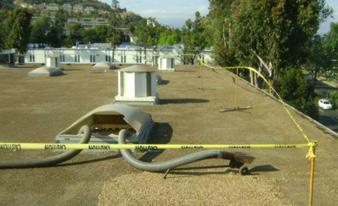
• All workers need to have training to recognize and avoid potential fall hazards.
Image from the scene of a fatal incident that happened when a roofer fell from a boom lift. (*7)
On a winter day, a roofer/foreman died after falling from a telescopic boom lift. He and four other roofing crew members were installing a new roof at a residence undergoing restoration.
5
Hazards All Construction Workers Should Watch Out For
03.23.2023 | Weeklysafety.com
Construction workers are exposed to hazards throughout the course of their work day. Review this list for some of the more common construction site hazards along with guidance on specific items that need to be included in the construction company’s workplace safety program.
According to OSHA, the leading causes of private sector worker deaths in the construction industry are falls, struckby hazards, electrocution and caught-in hazards. These Top 4 most fatal hazards are responsible for more than half of all the construction worker deaths that occur annually. Construction work is one of the most dangerous
occupations in America and even the most careful worker can be injured on an active worksite. Other work accidents and injuries that are common on construction sites are caused by other factors including falls from heights, collapses of trenches and scaffolds, electric shock, arc flashes or blasts, repetitive motion, and failure to use the proper personal protective equipment and devices.
MOST COMMON HAZARDS ON CONSTRUCTION SITES
Scaffolding Hazards. Falls occur when scaffolding is not assembled and/or used correctly. OSHA estimates that if correct protective methods were used, about 4,500 injuries and over 60 fatalities could be prevented annually.

Fall Hazards. Falls represent the biggest fatal hazard to construction workers . Falls may occur due to unstable work surfaces, human error, and misuse of or failure to use protection equipment.
Ladders and Stairway Hazards. Ladders and stairways are involved in injuries and fatalities each year on construction sites. Stairways are associated with trips and falls
Trenching Hazards. Injuries and fatalities often occur on construction sites due to trench collapses.
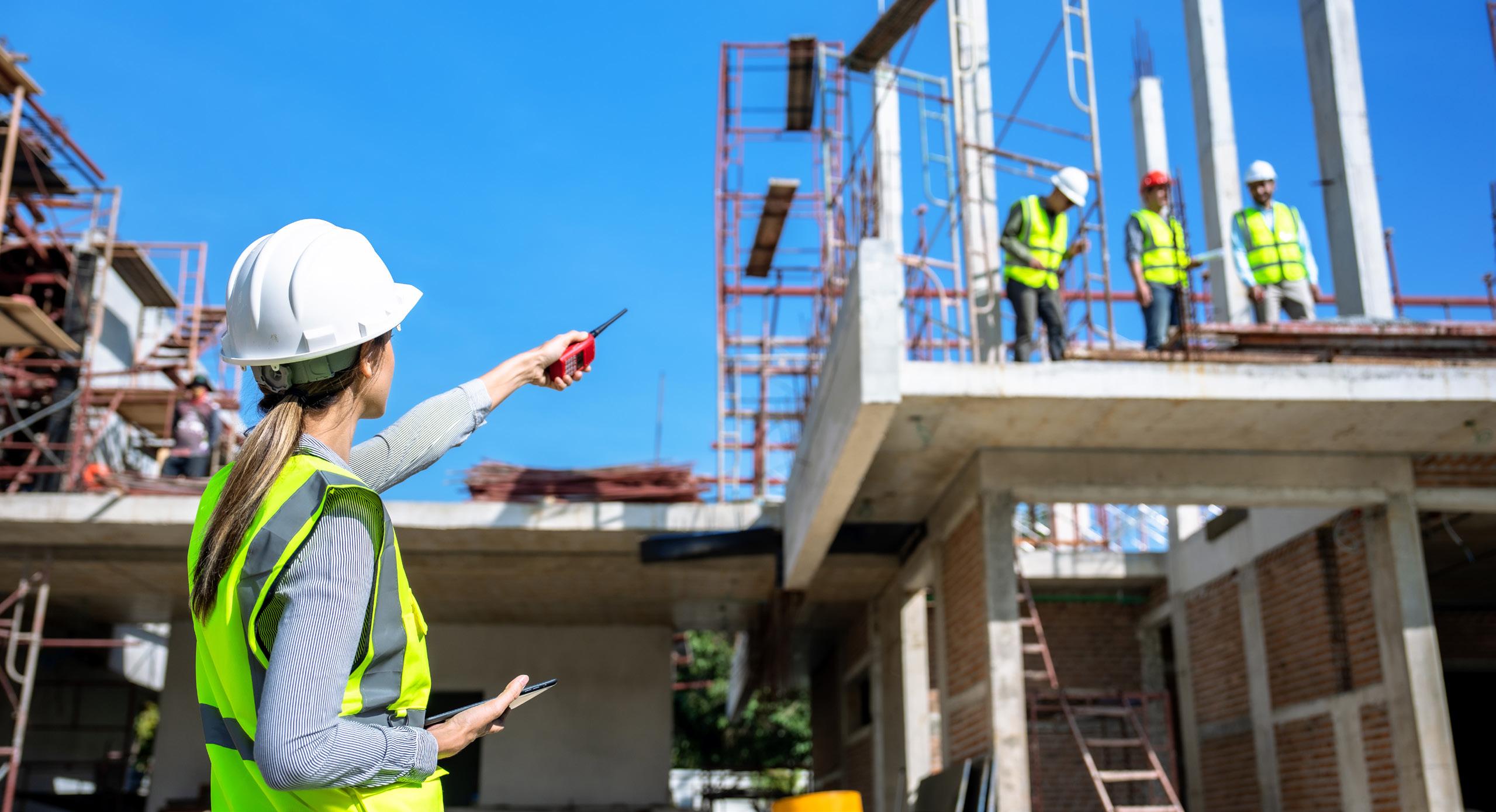
Crane Hazards. Cranes require regular inspections and correct use to prevent serious work accidents. Typical injuries involve workers being hit by an overhead load or trapped in the crane’s swing radius
Hazard Communication. Workers are often injured due to failure to communicate hazards involving chemicals, fires, explosions, and respiratory problems.
Forklift Hazards. OSHA estimates that about 95,000 forklift operators are injured every year, and another 100 are fatally injured annually.
Head Protection Hazards. Blows to the head can result in serious head injuries. All workers must wear hard hats in construction areas.
CONSTRUCTION SITE SAFETY TIPS
All employees must wear proper protective gear (PPE). Require the use of safety glasses or face shields for work operations that may result in foreign objects entering the eyes. Choose eye and face protection according to the hazards involved. Construction workers should wear slipresistant shoes or boots that have puncture-resistant soles and safety toes. Gloves must fit snugly and must be suited to the job.
Ensure electrical safety. Always shut off power and attach grounds for new or existing energized electrical circuits before working on them. Replace damaged electrical cords and cables promptly. Use extension cords with grounding prongs, and never bypass protective systems when using electricity. Keep equipment, ladders, and scaffolds away from overhead power lines. Never use multiple plug adapters.
Choose and use equipment and tools correctly. Scaffolds, for example, must be strong enough to hold four times the maximum intended load without shifting or displacing, and they must be assembled on solid footings. Choose the correct ladder for the job. Do not use metal ladders near

overhead power lines or for electrical work. Never exceed load capacities of trenches, ladders, stairways, cranes, and scaffolding.
Inspect equipment and tools regularly. Perform regular inspections of equipment and apply fixes and repairs promptly. Remove or label defective and malfunctioning equipment as soon as discovered. Perform prompt inspection of equipment such as trenches and scaffolding after vibrations and rainstorms. Fix slippery conditions on stairways promptly.
Handle chemicals properly and communicate any potential hazards. Communicate hazards involving chemicals, fires, explosions, and respiratory problems. Train employees to use Safety Data Sheets (SDS). Follow all SDS instructions for chemicals. Install cleanup kits near chemical areas and create written spill control plans, and train employees in cleanup procedures. Make sure to store chemicals safely.
Ensuring a safe and efficient work environment for construction workers must be given utmost importance and resources. It may be tempting to cut corners to save costs, but it is in everyone’s best interest to always follow all safety precautions.

7
Distracted Driving and the Myth of Multitasking

03.23.2023 |Weeklysafety.com
April is Distracted Driving Awareness Month and any topic on driving safety, like distracted driving, is a good idea for a safety meeting. The article below has some important points you can cover during a safety meeting and the National Safety Council provides even more driving safety resources on their website at nsc.org .
Distracted driving claims the lives of thousands of people each year. Distracted Driving can occur when you take your mind off driving, take your hands off the wheel, or take your eyes off the road. Personal grooming, eating, trying to find the perfect radio station or reading a text message are all common driving distractions that should be avoided. When behind the wheel, drivers should always be fully aware of their surroundings, remain focused solely on driving and avoid all types of distractions. A distraction is anything that directs your attention away from something else. Distracted driving occurs when a driver is attempting to do one or more other tasks in addition to driving and their attention becomes divided.
Inattention Blindness occurs when a driver fails to notice a visible hazard because their attention is focused on something else. When multitasking, the driver’s brain is switching back and forth between driving and the distraction, which can lead to slow reaction time and can cause a collision.
Avoid any of these distractions while driving:
• making or taking calls
• reading or sending text messages or emails
• browsing the internet
• scanning social media
• programming your GPS or maps app
• closing out jobs/work
• taking photos
MULTITASKING IS A MYTH, AND LEADS TO A DANGEROUS CONDITION CALLED INATTENTION BLINDNESS.
• looking at any app on your phone
• eating
• daydreaming or ‘zoning out’
• opening food or drinks
• smoking
• reaching into the back seat for an item
• allowing pets in the front seat or on your lap
• personal grooming or looking in the mirror at yourself
• bending down to pick up something that fell on the floor of the vehicle
NEVER drive and use your phone at the same time. Drivers on cell phones, even using the hands-free features , see just a fraction of their driving environment because their attention is being divided between the road and the conversation.
Hands-Free is not Risk-Free. Drivers looking out the windshield can miss seeing up to 50% of what’s around them when using the hands-free functionality with their cell phone.

Use your cell phone only when you are safely parked. Don’t look at your phone at red stop lights either!
• You may be compelled to keep looking at your screen after the light has turned green.
• The distraction may cause you to miss an abrupt stop in front of you after the light turns green and cause a rearend collision.
• As you continue driving after putting your phone down you may become further distracted by something you saw or read that takes your mind off the road.
Emergency, fire, police personnel and their vehicles can cause a distraction while driving. Pull over into another lane, further away, if possible, when coming up on emergency vehicles that are pulled onto the shoulder or side of a street/highway.
Accident scenes create distraction. Avoid staring at an accident scene when passing by on the roadway. Use caution when passing the accident scene but do not look back or beside you for too long as this takes your eyes off the road in front of you and could cause another accident!
When driving through a construction work zone , slow down and pay attention. There may be a flagger directing traffic and/or construction workers near the flow of traffic.
While on worksites, many things including equipment, materials, and other employees may be present. Ensure both hands are always on your steering wheel and you remain distraction-free while driving. ALWAYS stay fully aware of your surroundings.
HERE’S HOW TO PREPARE FOR A DISTRACTION-FREE DRIVE:
• Complete your phone calls, texts and emails.
• Finish your snack or your meal, and if you have a drink, make sure it has a secure lid on it.
• Program your GPS, start your playlist, queue up your audiobook or set up any other electronics that need to play while you are driving so that you don’t need to touch anything after you start driving.
• Enable the Do Not Disturb feature so you won’t be distracted by notifications.
• Put the phone in a glove box, purse, bag or other space that is out of reach.
• Before longer drives, inform your co-workers, family, and friends that you will be driving and that you will not be checking your phone or accepting calls while you drive, then allow time to safely park and check your messages, if needed.
• Avoid driving if you are upset, fatigued or sick.
9
Trenching and Excavation - Planning and Protection Will Help Workers Stay Safe

03.26.2023 | Safety + Health
On April 29, 2022, two brothers died when the 10-footdeep trench they were working in collapsed. The cavein was discovered only after the homeowner arrived to check the progress of a barn construction project near Grand Rapids, MI.
Emergency responders needed several hours to recover the bodies of the two men, both of whom worked for their family’s company.
The two deaths were among the 39 caused by full/partial trench or excavation cave-ins in 2022, according to OSHA, and they marked a sobering increase from the 15 recorded in 2021.
The spike spurred the agency to launch enhanced enforcement initiatives.
“Every one of these tragedies could have been prevented had employers complied with OSHA standards,” agency administrator Doug Parker announced in a July 14 press release. “There simply is no excuse for ignoring safety
requirements to prevent trench collapses and cave-ins, and leaving families, friends and co-workers to grieve when the solutions are so well-understood.”
THE HAZARDS OF TRENCHING AND EXCAVATION
The hazards of trenching and excavation are wellestablished. One is the sheer weight of soil. A cubic yard can weigh about 3,000 pounds. That’s as much as a car.
“The weight of soil is so heavy that it will crush you,” says a hazard alert from CPWR – The Center for Construction Research and Training. “You could die in minutes from a trench collapse, even if your head and arms are above the dirt.”
Another danger? The volatile nature of a trench or excavation. For example, water accumulation – from weather or from underground – can weaken the soil and lead to a cave-in.
“A change can happen at a moment’s notice,” said Mike Kassman, director of OSHA and disaster response training at CPWR. “It’s going to happen faster than you can react. “A lot of folks, maybe young workers, think they can get out faster than they actually can.”
Hazards can also stem from:
• Construction equipment and machinery
• Buried electrical or gas lines
• Gases and fumes
Among the trenching and excavation deaths in OSHA’s Accident Search for 2022 were an electrocution, a worker who died of severe heat stroke, another who was struck by a falling concrete pipe and one who fell into a trench.
IS IT A TRENCH OR AN EXCAVATION?
OSHA defines an excavation as “any man-made cut, cavity, trench or depression in an earth surface that is formed by earth removal.” A trench, meanwhile, is “a narrow excavation (in relation to its length) made below the surface of the ground.”
Typically, a trench is deeper than it is wide, but that width when measured from the bottom is no greater than 15 feet.
“Every trench is an excavation, but not every excavation is a trench,” said Kenneth Koroll, a safety and occupational health specialist in OSHA’s Office of Construction Services.
OSHA standards are minimum compliance. Employers should aim to go beyond the minimum requirements –especially when it comes to trenching and excavation.
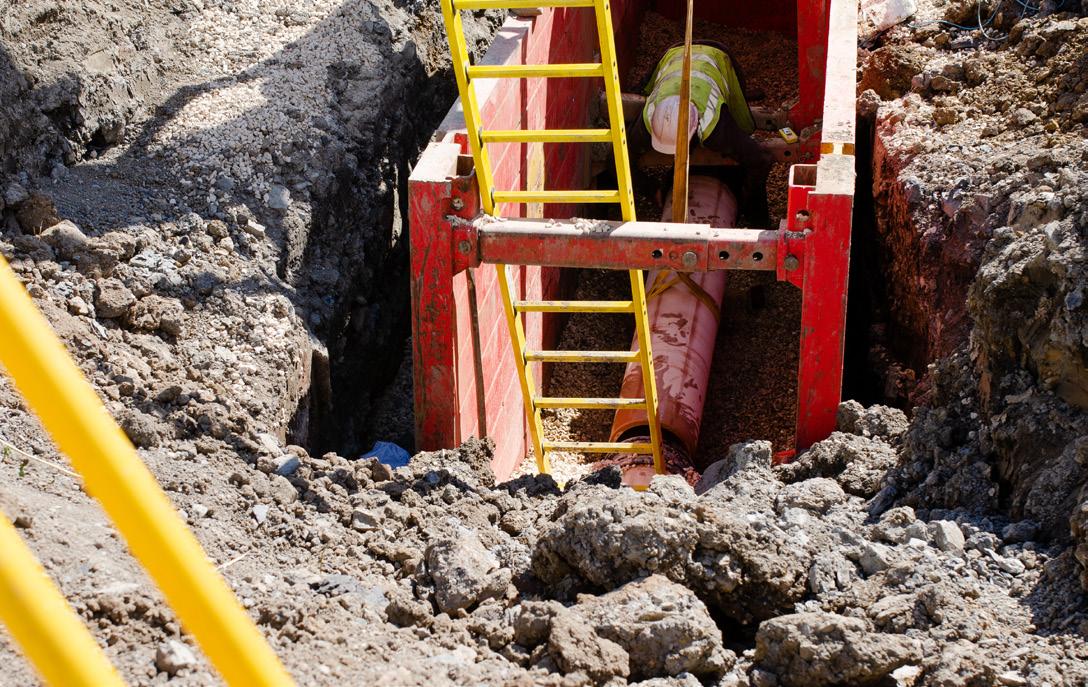
OSHA requires protective systems for excavations 5 feet or deeper, unless the excavation is composed entirely of stable rock. For excavations shallower than 5 feet, a protective system is required if a “competent person” finds any indication of a potential cave-in.
The main protective systems are:
Sloping: Cutting back the trench wall at an angle that’s inclined away from the excavation.
Benching: Forming one or a series of horizontal levels or steps into the sides of an excavation, usually with vertical or near-vertical surfaces between levels.
Shoring: Installing aluminum hydraulic or other types of supports to prevent soil movement and cave-ins.
Shielding: Using trench boxes or other supports to prevent cave-ins.
CPWR cautions that workers should never enter a trench unless it has been properly inspected. Once they’re in it, they should stay inside the protected areas only.
“Some types of soil are stable and some are not,” OSHA says. “When digging a trench, it’s important to know the type of soil you’re working with so you know how to properly slope, bench or shore the trench.”
Appendix A in 1926 Subpart P outlines the types of soils: stable rock and types A, B and C. The competent person has the responsibility of classifying the soil type.
THE COMPETENT PERSON
The task of inspecting a trench and its protective systems also belongs to the competent person. OSHA requires that inspection to take place daily and “as conditions change.”
TRENCHING AND EXCAVATION PROTECTIONS
OSHA’s excavation standards are covered in 1926 Subpart P, which includes 1926.650-652 and Appendixes A-F.
Casey Perkins, assistant regional administrator of enforcement programs for OSHA Region 6, and Ralph DiNapoli, director of safety for construction company Columbia in North Reading, MA, both emphasized that
Who qualifies as a competent person? Someone who is “capable of identifying existing and predictable hazards” and has the authority to correct or eliminate them. This person should also have the authority to stop work and remove employees from the trench or excavation if needed.
Additionally, the competent person is tasked with designing structural ramps, monitoring any water removal equipment and knowing when to check for hazardous gases.
11 ...continued
on next page
Perkins cautioned that the selection of a competent person could lead to a conflict of interest: The person responsible for safety also might be in charge of making sure a job gets done on time and on budget.
Time and financial pressures can lead to unsafe practices during trenching and excavation jobs. This is especially true in construction, where, for example, a subcontractor may have other jobs lined up at other sites later in the week. “We often hear, ‘I’m just going to be in there for a few minutes’ – but soil collapses do not follow a timeline,” Perkins said.
One possible way to eliminate that conflict of interest, he said, is getting “another set of eyes on the site” to ensure supervisors/lead persons aren’t giving into those pressures. “Even the smallest of employers can have unannounced jobsite visits by the owners, their purchasing department, their quality-control department, a third party (such as safety consultants),” Perkins said. “To ensure safety expectations are implemented, some companies are also requiring foremen and supervisors to send photos of proper safety systems as part of a daily job safety analysis.”
Kassman added that many contractors have safety officers or safety directors who act as that additional set of eyes for their subcontractors.
It’s important to give the competent person for a trench or excavation just one role: ensuring safety.
“It’s having that designated person there to solely do that job,” said Nick Fragola, safety manager with Colantonio Inc., a Holliston, MA-based construction company. “A lot of the times people complain about, ‘Well, you’re paying another person to do this,’ but [being a competent person is] a job.
TRENCHING AND EXCAVATION PLANNING
Planning is another crucial step for trenching and excavation safety – one that may get overlooked by some employers.


Part of that planning is making sure utility companies, or services such as 811 or DigSafe, are contacted to mark the location of utility lines before digging starts. Scheduled training may also be necessary, especially for inexperienced workers or those whose primary language isn’t English.
In addition, plans may be needed to ensure equipment such as pipes – and even excavated soil, sometimes known as spoil piles – are kept at least 2 feet away from the opening of an excavation. It’s an OSHA requirement. “I’ve been in trenches when people wanted to see what I was doing and they walk a little close” to the edge, Kassman said. “As they step a little closer, they could maybe knock stones down into the trench or even fall into the trench. Everybody wants to take a peek to see how deep it is and see what workers are doing. But if you get too close, you could add a potential problem – not only to yourself, but to the workers below.”
To keep unauthorized people away from a trench or excavation, barricades or signage may be needed. Employers also must make sure all the necessary tools and equipment are onsite. In one recent fatal incident, Perkins noted, the employer had a trench box and hydraulic shoring a half mile away from the worksite.
Another important part of planning is making sure employees have a safe way of entering and exiting a trench or excavation. OSHA requires this for excavations that are 4 feet or deeper. Employers need to ensure the safe way of entry and exit, such as a ladder, is no more than 25 feet away from workers.
“It’s just having a checklist, doing your pre-job meeting right in the morning or the day before, making sure, ‘OK, we need all of this equipment here before we start the task tomorrow, before everybody signs their morning huddle worksheet. We need to have all equipment checked off, inspected and ready to go,’” Fragola said.
Trench Safety Stand Down
This year’s Trench Safety Stand Down is set to take place June 19-23, in conjunction with Trench Safety Month.
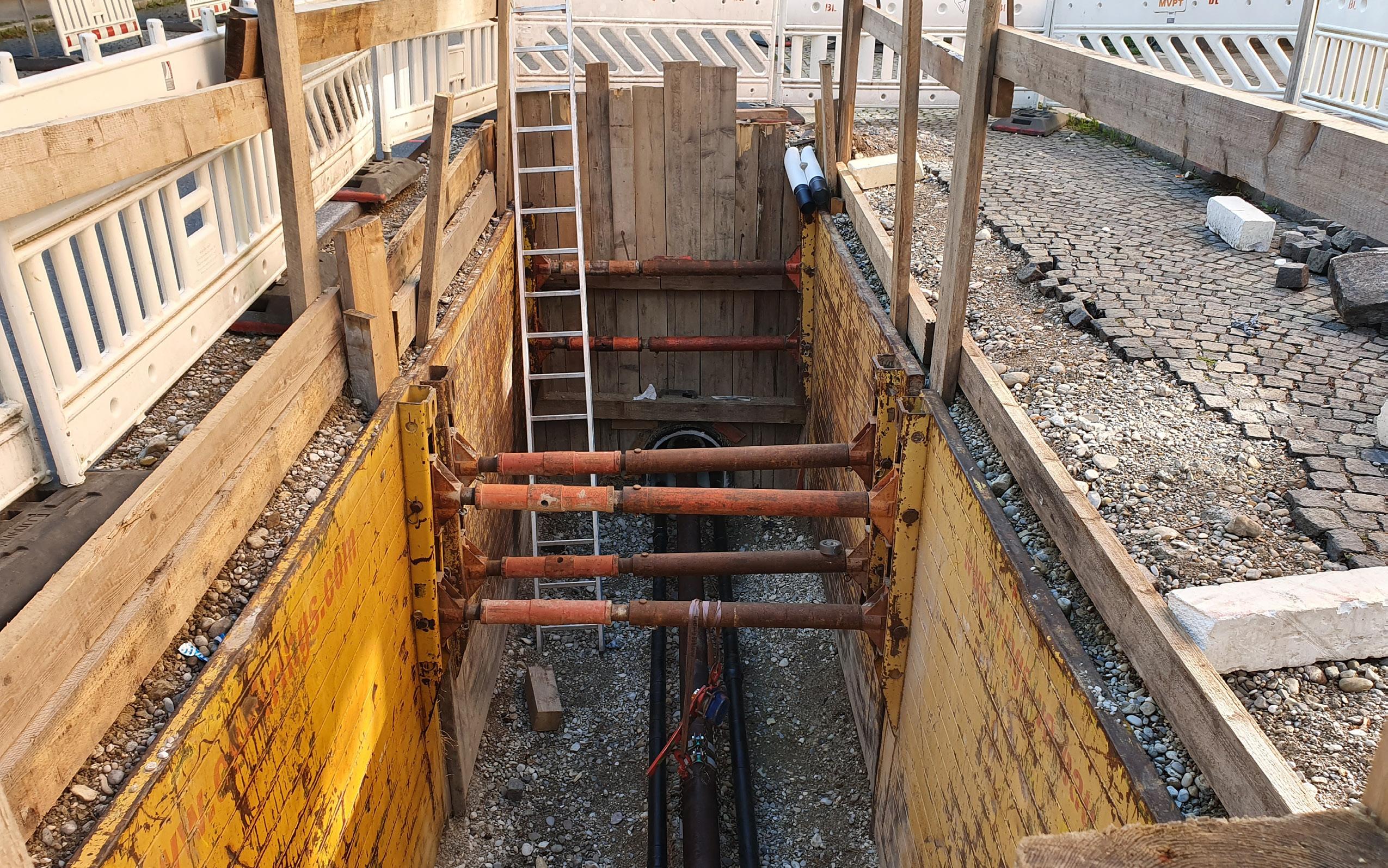
“A safety stand-down presents the opportunity for employers to talk directly to employees and others about safety,” the National Utility Contractors Association says. “These stand-downs will focus on trench and excavation hazards and reinforce the importance of using trench protective systems and protecting workers from trenching hazards.”
VETTING PROCESS
Columbia uses a “premobilization” meeting as part of its trenching and excavation planning, said DiNapoli and Mike Harrington, the company’s senior safety manager.
“You bring the subcontractor in and talk about what we’re going to do,” DiNapoli said. “We go over all the different scenarios: Have the operators been trained? Do they have a license for hoisting? What equipment are they using? Weather conditions. I mean, I can go on and on.”
The company takes another step to research subcontractors via a pre-qualifications process. That includes looking for any OSHA violations and information about previous work with Columbia.
“Let’s check this company for how many negatives they have, and if they have any infractions on our projects,” DiNapoli said.
He added that Columbia will reach out to other superintendents to get a second opinion on a foreman’s performance history, or they might have meetings with the subcontractors’ management, including any safety managers or directors, and Columbia’s management.
“It’s not to give a slap on the wrist.” Harrington said, “It’s that we want to ensure all craft workers go home safely. It’s critical we have safe subcontractors working for us.”
13
Workplan: Near Miss Reporting Management
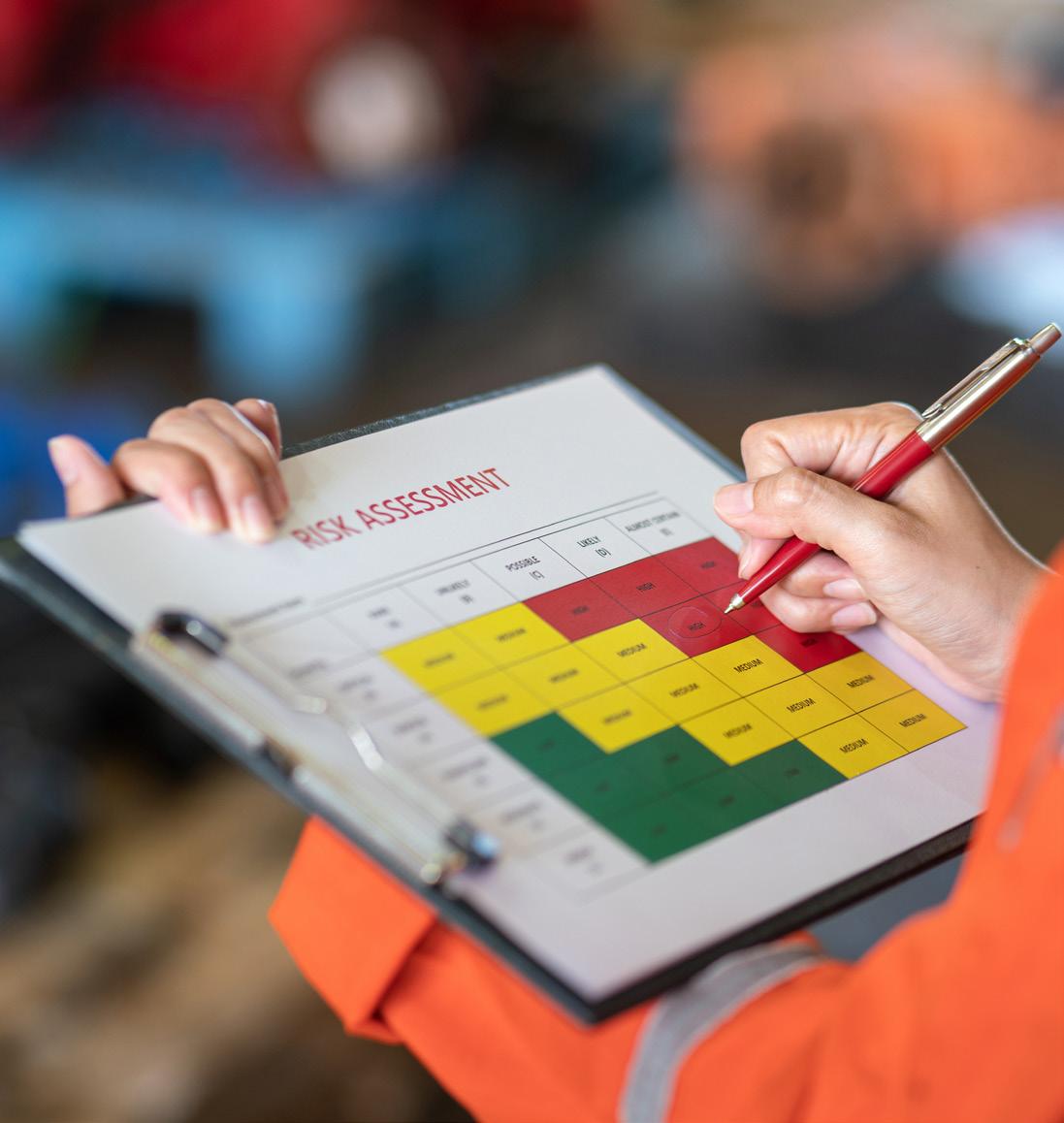
03.24.2023 | SafetyNow
Seventy-five percent of all accidents are preceded by one or more near misses, according to the National Safety Council. So, if you’re trying to reduce the number of injuries and incidents with property damage and other incidentrelated loss, it makes sense to measure and manage your near misses.

WHY NEAR MISSES ARE SO IMPORTANT
It’s been recognized that focusing on minor incidents, including near misses provides the wherewithal to reduce the probability of major incidents. Near misses occur much more frequently than serious incidents. They’re also smaller in scale, simpler to analyze and easier to resolve.
Working from the top down, major incidents can often be traced back to several minor ones that happened earlier. By addressing the causes of these “precursor events,” you can prevent the major events from ever occurring.
Example: Several rows of shelving collapse in a storeroom. No one is hurt, and only minor property damage is done. The investigation reveals the shelves collapsed because they were overloaded. Once you know this, you can revise your stocking restrictions, ensure that shelves are safely
loaded and prevent any more shelves from collapsing due to overloading.
9 STEP WORKPLAN FOR NEAR MISS MANAGEMENT
Near miss reporting, investigation and correction have become common practice. And like other safety activities, years of practice have provided insight on near miss management. Research from the Wharton Business School and others has identified several hallmarks of an effective near miss management program:
1. DEFINE “NEAR MISS” BROADLY
The first thing researchers noticed is that at companies that manage them effectively, the term “near miss is defined broadly to include not just events but things like unsafe conditions and unsafe behaviors. Event triggers were also broad typically including:
• Minor incidents/injuries that had the potential to be more serious;
• Events where injury could have occurred but didn’t;
• Events where property damage resulted or could have resulted but didn’t;
• Events where a safety barrier was challenged, such as by a worker bypassing a machine guard regardless of whether it caused a potential injury or damage event; and
• Events where potential environmental damage could result.
The definition recommended by the researchers to maximize near miss management effectiveness: “A near miss is an opportunity to improve health and safety in a workplace based on a condition or an incident with potential for more serious consequences.”
2. SETUP CLEAR AND SIMPLE REPORTING PROCEDURES
You can’t manage near misses and learn from them unless you know they’re occurring. So once a near miss is identified, it should be reported, preferably in writing, by either the person who identified the near miss or by a supervisor to whom a near miss was reported to. The researchers recommend having a clear and simple procedure for reporting near misses to encourage this process and increase the probability of reporting near misses.
3. PROVIDE TRAINING
Workers may be reluctant to report near misses. They may be afraid of being disciplined if the near miss involved a violation of your safety rules or procedures. Or they may not believe management will actually do anything to improve
safety if they report a near miss. So, they stay mum about their close calls.
To overcome workers’ reluctance to reporting near misses, train them on the value of near misses and their role in properly managing these events. This type of training should cover the following:
• What near misses are and how to identify them;
• Why near misses are important;
• The role of each person involved in near miss reporting;
• What a near miss management system is and how it works, including the responsibilities of all management levels;
• How to report a near miss; and
• How to prioritize a near miss.
You can also encourage near miss reporting by providing incentives or by telling workers that they’ll be disciplined for not reporting near misses. And taking swift action in response to a reported near miss can also encourages reporting because it demonstrates to workers that management is listening and taking safety seriously.
But the researchers don’t recommend that you allow anonymous near miss reporting for two reasons. First, it’s often necessary to follow-up with the person who reported the event to determine its root cause. Second, anonymous reporting suggests that near misses are unfavorable and undesirable events.
4. PRIORITIZE NEAR MISS INCIDENTS
Once near misses are reported, you need to prioritize them to determine:
• What steps to take next;
• How much attention to give the incident;
• How deeply to analyze its causes;
• The resources available to implement solutions; and
• How, if at all, you’ll disseminate information about the incident throughout the company.
5. DISTRIBUTE RELEVANT INFORMATION
Companies that manage near misses effectively do a good job of distributing appropriate information about the incident. In such systems, the information is:
• Transferred quickly;
• Routed to all appropriate people; and
• Communicated in a useful and understandable format.
15
6. DETERMINE THE CAUSE
Near miss management requires identification of indirect and direct causes of an incident. Don’t hesitate to form investigative teams when the causes of incidents aren’t readily apparent.
7. DETERMINE SOLUTIONS
The next hallmark of effective near miss management is to determine one or more solutions to the identified causes. Of course, hazard elimination is always the preferred solution; but the system must provide for hazard management or control where total elimination isn’t feasible. The hierarchy:
• Elimination of the cause of the hazard;
• Reduction of the potential hazard level or degree of risk of exposure to it;
• Installation of safety devices;
• Installation of warning signs to alert people to the hazard;
• Implementation of new safe work procedures to account for the hazard; and
• Increased worker awareness of the hazard, such as through safety talks.
8. IMPLEMENT SOLUTIONS
Once you identify the necessary solutions, implement them and inform anyone affected by the near miss, such
as workers and supervisors who work with the equipment involved or in that section of the workplace. And if the solution includes new or revised safety procedures, make sure to train all workers who’ll have to use these procedures.
9. MONITOR SOLUTIONS
The final phase of near miss management is monitoring the changes made to ensure that they effectively address the causes of the near miss incident. In addition, remedying one problem can sometimes create other unforeseen hazards, particularly for subtle changes. Thus, managing these changes and ensuring no new hazards are created is critical to the success of a near miss program. And make sure that the person who reported the near miss is aware of the outcome of this process.
BOTTOM LINE
Near misses are a largely untapped safety improvement resource. An effective near miss management program can help you tap the potential of this valuable source of safety information and use it to improve your workplace’s overall safety program.
Investigations By Department Of Labor, Vernon Police Lead To First-Degree Manslaughter Charges In Connecticut Trench Fatality
03.17.2023 | U.S. Department of Labor
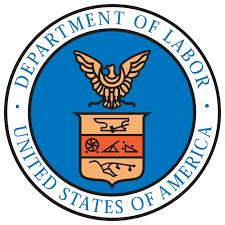
Employer, equipment operator also face first-degree reckless endangerment.
Incident: Fatal trench collapse in Vernon, Connecticut
Date: July 22, 2022
Background: Inspectors with the U.S. Department of Labor’s Occupational Safety and Health Administration, special agents with the department’s Office of Inspector General, and detectives with the Town of Vernon’s Police Department investigated the collapse of an 8-foot-deep trench that killed an employee of Botticello Inc., a Manchester construction contractor.
OSHA determined that Botticello failed to provide legally required safeguards and issued the company a citation for willful violations with proposed penalties of $375,021. The company has contested OSHA’s findings with the independent Occupational Safety and Health Review Commission.
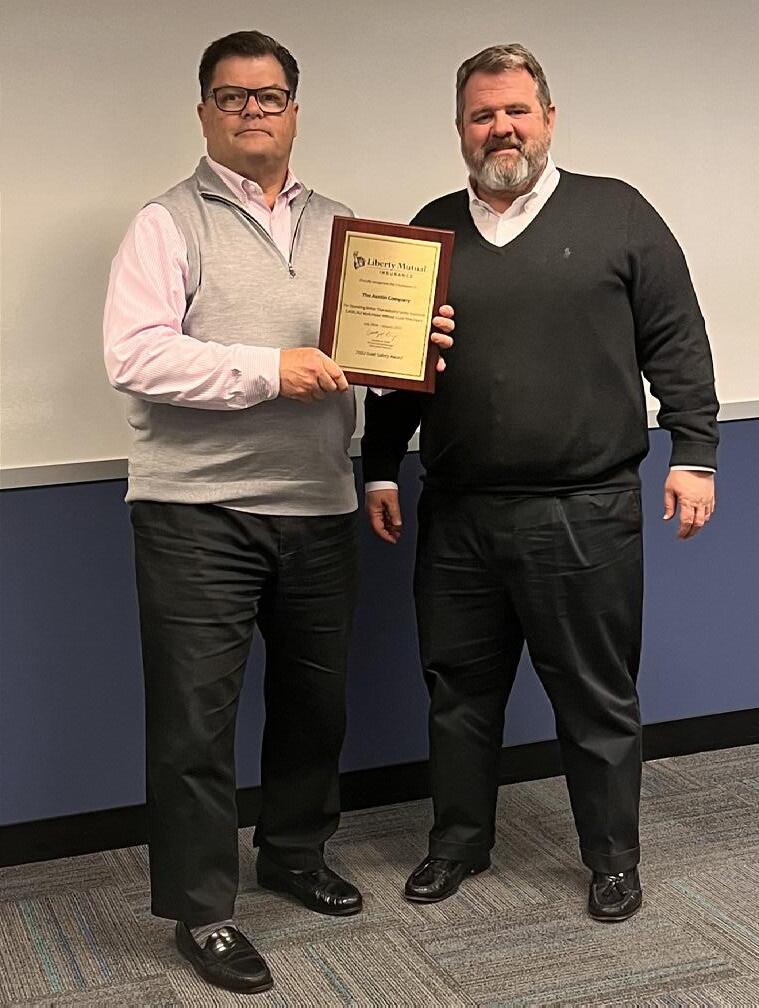
On March 3, 2023, the investigations led the Vernon Police Department to arrest Dennis Botticello, owner of Botticello Inc. and Glen Locke, a Somers, Connecticut equipment operator, on charges of first-degree manslaughter and first-degree reckless endangerment.
Quote: “Dennis Botticello and Glen Locke now face first-degree manslaughter and first-degree reckless endangerment charges for failing to provide legally required safeguards that could have prevented a deadly cave-in,” said OSHA
Regional Administrator Galen Blanton in Boston. “These arrests are the result of collaborative investigations by local and federal law enforcement groups that show OSHA will use all available enforcement tools at its disposal to ensure workers are afforded the protections provided by the Occupational Safety and Health Act.”
Recognizes
17
Liberty Mutual Insurance
Austin For Operating Better Than Industry Standards 5,400,762 Work Hours Without A Lost Time Injury.
Mike Pierce and Matt Eddleman





 Image from the scene of a fatal incident when a 33-year old fell 8 feet from his step ladder. (*4)
Image from the scene of a fatal incident when a 33-year old fell 8 feet from his step ladder. (*4)


















